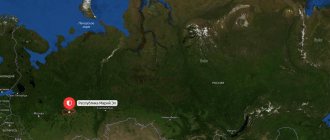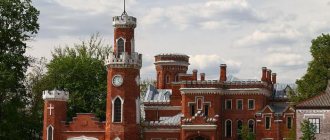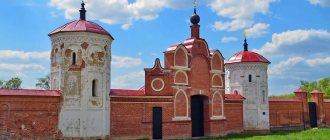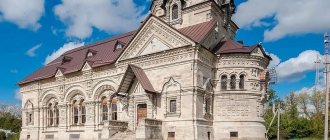What thoughts come to mind after the word “Karachay-Cherkessia”? First: the republic is somewhere in the Caucasus. Second: the Karachais and Circassians are mountain peoples who were repressed and forcibly resettled from their native territories to other regions. Third: amazing, amazing nature, mountains, sky, rivers and lakes. And fourth: delicious food and real Caucasian cuisine. All this is true, but it seems that something has been forgotten - mineral water. Perhaps everyone has heard the name “Arkhyz” at least once in their life. Arkhyz is a city in Karachay-Cherkessia, where this water is extracted, bottled in beautiful bottles and sent to stores throughout the country. But not only this type of medicinal water is mined here. There are many springs in the mountains, local residents know them and use them, perhaps even sharing their “gold” with travelers. In general, Karachay-Cherkessia is an excellent place for outdoor recreation, recreation, hiking and mountaineering. Lovers of passive pastime can also come here: numerous sanatoriums and resorts are simply ideal for homebodies and couch potatoes - you can improve your health and have a good rest. In any case, you need to go to the republic without hesitation!
What holiday is it today?
February 10, 2022, Thursday
Today are holidays, events: Diplomat's Day Tomorrow: World Sick Day Discovery of insulin
Today is the Orthodox holiday: St. Ephraim the Syrian. Venerable Ephraim of Novotorzhsky. Venerable Ephraim of Pechersk, Bishop of Pereyaslavl. Venerable Theodosius of Totem, Spasosumorin of the monastery, leader and founder... Tomorrow: Transfer of the relics of the holy martyr Ignatius the God-Bearer. Saints Gerasim, Pitirim, Jonah, bishops of Great Perm, Ustva...
Today is a national holiday: Ephraim's Day... Tomorrow: Lawrence's Day
Urban districts and districts
- Cherkessk urban district (includes the only settlement: the city of Cherkessk)
- Karachaevsky urban district (includes settlements: the city of Karachaevsk, the city of Teberda, the urban-type settlement of Dombay, the urban-type settlement of Ordzhonikidzevsky, the urban-type settlement of Elbrussky, the village of Malokurganny, the village of Mara-Ayagy)
- Abaza district (administrative center - Inzhich-Chukun village, OKATO code - 91 201 000)
- Adyge-Khablsky district (administrative center - Adyge-Khabl village, OKATO code - 91 203 000)
- Zelenchuksky district (administrative center - the village of Zelenchukskaya, OKATO code - 91 210 000)
- Karachaevsky district (administrative center - the city of Karachaevsk, OKATO code - 91 215 000)
- Malokarachaevsky district (administrative center - the village of Uchkeken, OKATO code - 91 220 000)
- Nogai district (administrative center - the village of Erken-Shahar, OKATO code - 91 223 000)
- Prikubansky district (administrative center - the village of Kavkazsky, OKATO code - 91 225 000)
- Urupsky district (administrative center - Pregradnaya village, OKATO code - 91 230 000)
- Ust-Dzhegutinsky district (administrative center - the city of Ust-Dzheguta, OKATO code - 91 235 000)
- Khabez district (administrative center - Khabez village, OKATO code - 91 240 000)
Seasons
Seasons, four periods of the year (spring, summer, autumn and winter) characterized by certain average temperatures. The period during which the Sun passes through one of these sectors is called the season. Spring in the Northern Hemisphere and autumn in the Southern Hemisphere begin when the Sun passes through the initial circle of declination and its right ascension is 0° (vernal equinox). Summer in the Northern Hemisphere and winter in the Southern Hemisphere occur when the sun's right ascension is 90° (summer solstice). Autumn in the Northern Hemisphere and spring in the Southern Hemisphere begin when the sun's right ascension is 180° (autumnal equinox). The beginning of winter in the Northern Hemisphere and summer in the Southern Hemisphere is considered to be the winter solstice, when the direct ascension of the Sun is 270°... Next: Seasons. Russian folk calendar. Monthly words...
Lake Tumanly-Kol
Trout reserve.
We continue to explore the most beautiful places in Dombay. Next up is a 2,000-year-old lake whose name translates as “foggy place.” And it is justified, because at an altitude of 1,850 meters above sea level, fogs are not uncommon.
The simplest tourist route in Dombay has been laid to the picturesque Lake Tumanly-Kel - it can be completely covered by car without any difficulty. Tourists come here to look at the trout (the second name of the lake is Trout) and feed the fish - they won’t be able to feast on it themselves: fishing is prohibited in the protected area. Daredevils can take a swim - like any glacial lake, Tumanly-Kol does not warm up well.
- Where and when: Tumanly-Kol is located in the same Teberda Nature Reserve, in the Gonachkhir Gorge. People often come to the lake in the summer; entry through the checkpoint is possible from 8.00 to 18.00, the cost of the environmental fee is 200 rubles per person and the same for a car. The nearest settlement is the village of Dombay (18 km). The distance to Cherkessk is 130 km, to Mineralnye Vody – 200 km.
Folk calendar about every day
Every day one season always replaces another and this determines a person’s way of life. In connection with this, a folk calendar was formed in which there were practically no nameless, unmarked days. Every day was special, had its own purpose. All this was determined by climate conditions and astrological phenomena.
A calendar is a system for counting periods of time. The first calendars arose a long time ago, in ancient times, because there was a need to measure time. The word calendar comes from the Latin words caleo - to proclaim and calendarium - debt book. This is due to the fact that in Ancient Rome the beginning of each month was especially proclaimed, and because it was customary to pay debts on the first day of the month. Different peoples counted time differently. Some calendars are based on the changing phases of the moon - lunar calendars; in others - the change of seasons - sunny; in others, the length of the year was coordinated with the change of seasons, and the counting of months was associated with the phases of the Moon. Such calendars are called lunisolar.
In Rus', the calendar was called a monthly calendar. Every day, the month book covered the entire year of peasant life, “describing” day by day, month after month, where each day had its own holidays or weekdays, customs and superstitions, traditions and rituals, natural signs and phenomena. The cyclical nature of the calendar is reminiscent of human life, where spring is youth, summer is heyday, autumn is the time of harvesting fruits (it’s good if there are some, otherwise you can live your life without collecting fruits), winter is the time of wisdom and peace. This cyclicality and rhythm determined the way of life of the farmer. The folk calendar was an agricultural calendar, which was reflected in the names of the months, folk signs, rituals and customs. Even the determination of the timing and duration of the seasons is associated with real climatic conditions. Hence the discrepancy between the names of the months in different areas... Next: Folk calendar...
Links
The edges Altai • Transbaikal • Kamchatka • Krasnodar • Krasnoyarsk • Perm • Primorsky • Stavropol • Khabarovsk Regions Amur • Arkhangelsk • Astrakhan • Belgorod • Bryansk • Vladimir • Volgograd • Vologda • Voronezh • Ivanovo • Irkutsk • Kaliningrad • Kaluga • Kemerovo • Kirov • Kostroma • Kurgan • Kursk • Leningrad • Lipetsk • Magadan • Moscow • Murmansk • Nizhny Novgorod • Novgorod • Novosibirsk • Omsk • Orenburg • Oryol • Penza • Pskov • Rostov • Ryazan • Samara • Saratov • Sakhalin • Sverdlovsk • Smolensk • Tambov • Tver • Tomsk • Tula • Tyumen • Ulyanovsk • Chelyabinsk • Yaroslavl Federal cities Moscow • St. Petersburg • Sevastopol3 Autonomous region Jewish Autonomous okrugs Nenets1 • Khanty-Mansiysk - Yugra2 • Chukotka • Yamalo-Nenets2 1 Located on the territory of the Arkhangelsk region 2 Located on the territory of the Tyumen region 3 The Republic of Crimea and Sevastopol are located on territory whose annexation to Russia has not received international recognition
Fishing calendar for every day
The fishing calendar should not be taken as an absolutely indisputable truth. Fish biting is greatly influenced by a whole range of natural factors, as well as the influence on the nature of man himself. You must not forget that the fish’s bite depends and is determined not only by the calendar dates and biological cycles of their life, reflected in the calendar, but also, no less, by the state of their habitat; the bite also depends on weather conditions: air and water temperatures, cloudiness, wind direction and strength, etc... Next: Fishing calendar...
Cities of the Karachay-Cherkess Republic
Cherkessk is the capital of Karachay-Cherkessia. A typical small cozy town. As you know, subways are built in millionaire cities. There aren't even trams here. City transport is represented by buses and trolleybuses. There is work, but they pay little for it.
Ust-Dzheguta is the second most populous city in Karachay-Cherkessia. 30 thousand people live here. For comparison, this is only 30 apartment buildings. The Great Stavropol Canal begins in Ust-Dzheguta, there is a railway and several enterprises.
Ust-Dzheguta. Photo of the Russian Alps (https://fotki.yandex.ru/users/russianalps/)
Orthodox calendar about every day
Orthodox calendar: Orthodox, Church and Christian holidays.
The church year is an alternation of weekdays and holidays. On weekdays, a person is called to work “by the sweat of his brow to earn his bread.” Holidays are given in order to feel liberation, to rise above the bustle and routine of the world, to feel involved in the highest of worlds, “where there are no illnesses, sorrows and sighs, but endless life.” Since ancient times, holiday cycles have been associated with the seasons. The pagans associated them with the worship of the forces of nature, the cult of which in the Old Testament was replaced by gratitude to the Creator for the universe. And although the connection between holidays and the seasons has not completely lost its power, since God is present in everything, in the plant and animal world, in human works, it nevertheless faded into the background, giving way to a spiritual foundation built on the Sacred Scriptures. The history of Orthodox holidays dates back to the times of the Old Testament. Each of the Orthodox holidays is dedicated to the remembrance of the most important events in the life of Jesus Christ and the Mother of God, as well as the memory of saints... Next: Orthodox calendar...
HISTORY OF KARACHAY-CHERKESSIA
It is extremely interesting and rich in events of varying importance. The first people settled here in the early Stone Age: several sites of ancient people and samples of labor tools were found in the region. But only with the advent of the Alans (VI-VIII centuries) can we talk about the dynamics of historical development. A little later, in the 9th-10th centuries, the lands were an integral part of the Alanian state. In the 14th century they were constantly attacked by Turks and Crimean Tatars, so in the middle of the 16th century a political union was established with Russia. The country was included in imperial Russia only at the beginning of the 19th century. Cossack troops were stationed here to maintain order and guard the borders. After the abolition of serfdom in 1868, industry began to develop in the region, mainly food, and mines and mines began to operate. By the beginning of the 20th century it was relatively developed and peaceful. After the establishment of the power of the councils, significant transformations took place in Karachay-Cherkessia. Since 1918, its lands have been part of the Kuban Soviet Republic, and until 1922 they belonged to several other regions. In 1922, the Karachay-Cherkess Republic was founded, although
this administrative unit was divided several times. And in 1926, the territory was scattered into several regions: Karachay Autonomous Okrug, Cherkessk National. district and two districts - Zelenchuksky and Batalpashinsky. The first, in 1943, was still divided between the Georgian SSR, the Krasnodar Territory and the Stavropol Territory, and the local population was repressed. During the Second World War, fierce battles were fought in the region, but Hitler’s army failed to conquer the Caucasus. 1957 became a special year in the life of Karachay-Cherkessia: the Karachay-Cherkess Autonomous Okrug, which is part of the Stavropol region, was founded. This state of affairs lasted until 1991, when the region became an independent administrative-territorial unit. Attempts were made to divide it into smaller territories, but as a result of the 1992 referendum, the integrity of the republic was preserved. The modern Karachay-Cherkess Republic is an agricultural and industrial region. A significant share of the budget comes from tourism: extreme sports and resort activities are developed here.
NATURE
One can talk endlessly about the picturesque nature of the Caucasus and the regions located here; Karachay-Cherkessia is no exception to the rule. This region is located in the foothills of the Caucasus. The local climate here is very good: winters are mild and short, summers are warm and humid. If we talk about natural zones, we can distinguish several of them - forest-steppe, steppe, alpine and subalpine meadows. The flora is represented by several hundred species of herbaceous plants and shrubs. Of the former, the most common are shepherd's purse, common mullein, sage and elecampane. There are fewer shrubs, they are found mainly on dry slopes and on forest edges - barberry, rose hips, sea buckthorn, various types of ferns. The fauna of Karachay-Cherkessia is inherently unique. Here there are species that live only in this territory - the Caucasian black grouse, the Promethean vole and the Caucasian snowcock. In general, in the region you can also find more common animals - roe deer, deer, bison, gophers, hares and beavers. Naturally, there are also endangered species listed in the Red Book. The list of these includes rare species that are carefully protected, for example, in one of the areas a deer nursery has been created, where a little more than 200 individuals currently live. In Karachay-Cherkessia, there are also natural protected zones, for example, the Teberda Nature Reserve, where not only plants and animals are protected, but also soils, rocks, etc. But there are catastrophically few such structures; to preserve the natural heritage of the region, more such places need to be organized!
RESERVOIRS
There are more than 300 bodies of water in Karachay-Cherkessia: alpine lakes, ponds, rivers, streams. There are 172 rivers in the region, and the largest are Kuban and Urup, Maly and Bolshoi Zelenchuk. There are more than 130 lakes here, all of them are mainly located in the mountains. One of the most interesting specimens can be called Lake of Love, hidden in the mountains near the city of Arkhyz. The name is given to it by its shape; it looks like a heart. The water in the reservoir is very clean and transparent, and beautiful flowers grow along the banks. It is best to come here in the spring, although it is very beautiful here in the summer. There are many waterfalls in the mountains, all of them are a stunning sight: rapid streams of water fall from a great height and irrigate the entire surrounding area with their icy spray. Very often you can see a rainbow here, and it is lucky. One of the most picturesque waterfalls is Alibeksky. It is located in the gorge of the same name, on the territory of the Dombay glade. The giant is interesting because it does not fall vertically, but rushes its waters along the mountain slopes. The spectacle is amazing: foamy waves, small splashes, a seething stream, all this personifies the power and strength of the elements. In addition to natural reservoirs, there are also artificial ones in the republic - the Kuban reservoir and the system of the Great Stavropol Canal supply water to the lands of the republic and Stavropol region. In other words, there is no shortage of water in Karachay-Cherkessia!
Russian folk calendar for every day
The word “sign” comes from the word “notice”, i.e. observe. As a result of observing what happens around a person every day, he accumulates life experience. This knowledge was passed down from generation to generation, carefully preserved and people trusted it as a sacred book. Many signs have come to us from the depths of centuries without losing their knowledge. Each of us is free to choose: to dismiss all this as an absurd superstition or to take a closer look at the signs and take the centuries-old experience of generations more seriously. Most of us, when taking exams, ask them to scold them, boasting about some kind of good fortune or luck, spit so as not to jinx them or knock on wood, take a detour if a black cat crossed the road, are afraid of the number 13 and much more. And who among us does not have lucky things, numbers? Who has never resorted to the help of fate at least once in their life, who has not believed in secrets? It’s as if everything connected with signs is hidden somewhere deep in our subconscious. Often we remember them mechanically, unconsciously, or just as a joke. But, undoubtedly, the signs contain a lot of accurate knowledge and practical wisdom of our ancestors. They cover all the characteristic, often difficult to perceive, natural phenomena. Signs have preserved a lot of what was in old folk holidays and customs; they help predict the weather, grow crops... Next: Folk signs...
Sofia Lakes
“Blue Eyes” by Arkhyz.
At an altitude of 2,800 meters above sea level, you will see one of the main attractions of Karachay-Cherkessia. The name of the system of three crystal clear lakes was given by Mount Sofia, located nearby. The hiking route to the reservoirs is not easy, but all efforts are compensated by breathtaking views of mountain meadows and the nearby village of the famous Arkhyz.
The ascent to the Sofia Lakes along steep mountain slopes will take 4-5 hours. It is difficult to swim in them: the water warms up slowly, the maximum temperature is +12 °C. But thousands of tourists come here not for the sake of swimming: the local nature and landscapes are worth the difficult journey.
- Where and when: a comfortable time to visit the Sofia Lakes is from July to September. All tourist routes start from the village of Arkhyz (15 km). The distance to Cherkessk is 115 km, to Mineralnye Vody – 215 km.
Holiday calendar, dates and events of the year
All state and professional holidays in Russia, including significant World and International holidays, and other equally interesting holidays and events about every day.
The holiday has always kept pace with the history of mankind. Social time can be divided into three types: everyday life (weekdays), weekends and holidays. Everyday life is a series of practices repeated day after day and every day (work). Weekends are regular breaks from the rush of everyday life. It is believed that on weekends a person should restore his strength after working days. Day off, non-working day. A holiday is a day of celebration established in honor or in memory of someone or something. A day or series of days celebrated by the church in memory of a religious event or saint... Next: Calendar...
Content
- 1 Administrative-territorial structure
- 2 Municipal structure
- 3 Urban districts and districts
- 4 Rural and urban settlements of the regions of the Karachay-Cherkess Republic 4.1 Abaza district
- 4.2 Adyge-Khablsky district
- 4.3 Zelenchuksky district
- 4.4 Karachaevsky district
- 4.5 Malokarachaevsky district
- 4.6 Nogai district
- 4.7 Prikubansky district
- 4.8 Urupsky district
- 4.9 Ust-Dzhegutinsky district
- 4.10 Khabezsky district
Prayer book, Orthodox prayers for every day
Prayer is the most powerful means for healing all illnesses - both physical and mental. Prayers can be laudatory or grateful, petitionary and repentant. If we have offended God, sinned, we must ask Him for forgiveness, that is, repent. Such prayers are called repentant prayers. If everything is fine with us, if we and our loved ones are healthy and prosperous, if we have a place to live, something to wear, something to eat, we must glorify and thank God for this. Such prayers are called praise or thanksgiving. If some misfortune, illness, trouble or need happens, you need to ask God for help. Such prayers are called petitionary... Next: Orthodox prayers...
Zodiac, astrological, eastern calendar. Zodiac signs
In ancient times, to establish the calendar, priests used knowledge of the positions of all the planets. Before the reform of Peter 1, the New Year was celebrated on the Day of the Autumn Equinox. On this day, according to ancient legend, the most peaceful treaty was concluded between the Great Race (ancient Slavs) and the Great Dragon (ancient Chinese) and it was approximately 7518 years ago... For the ancient Slavs, the calendar month corresponded to the lunar cycle from new moon to new moon, taking into account such Thus, the relationship of the entire annual cycle with astronomical and natural phenomena. There was no coherent calendar system. The main natural phenomena are still considered to this day to be the days of the solar equinox and solstice - the Slavic holidays Maslenitsa, Kupala, Ovsen and Kolyada. But during the time of Peter 1, all ancient Slavic calendars were abolished and a new Western European calendar from the Nativity of Christ (Julian calendar) was introduced, while the beginning of the calendar was moved to January 1. The Julian calendar (old style) did not take leap days into account and accumulated one extra day every 128 years. After the October Revolution in 1918, the Gregorian calendar (new style) was introduced in Russia, according to which an amendment of 13 days was introduced. The calendar of the ancient Slavs was based on two planets: the Sun and the Moon. And now they don’t use anything at all. The calendar has become static. There is no such thing as the calendar, it turns out, resting on some planet. Nobody even knows about it. There are just some standard numbers, there are months and holidays. The calendar is based on the Sun and Moon. Why is this so? Because these two luminaries influence the Earth. The Earth revolves around the Sun, and the Moon revolves around the Earth. And these two luminaries create the atmosphere on the planet. From here the calendar is built... Next: Astrological calendar...
Rural and urban settlements of the Karachay-Cherkess Republic regions
Abaza district
- Rural settlement Inzhich-Chukun (aul Inzhich-Chukun)
- Rural settlement Kara-Pago (aul Kara-Pago)
- Rural settlement Kubina (Kubina village)
- Rural settlement Psyzh (aul Psyzh)
- Rural settlement Elburgan (Elburgan village)
Adyge-Khablsky district
- Rural settlement of Adyge-Khabl (Adyge-Khabl village)
- Rural settlement of Apsua (Apsua village, Baralki village, Dubyansky farm, Sparta village)
- Rural settlement Grushka (Grushka village, Abaza-Khabl village, Malo-Abazinsk village, Tapanta village)
- Rural settlement Sadovoye (Sadovoye village)
- Rural settlement Staro-Kuvinsk (aul Staro-Kuvinsk, aul Vako-Zhile)
- Rural settlement Ersakon (Ersakon village, Kiev-Zhuraki village, Novo-Kuvinsk village)
Zelenchuksky district
- Rural settlement Arkhyz (Arkhyz village, Nizhny Arkhyz village)
- Rural settlement Dausuz (Dausuz village, Nizhnyaya Ermolovka village, Khusa-Kardonik village)
- Rural settlement Zelenchukskoye (village Zelenchukskaya, Leso-Kyafar farmstead)
- Rural settlement Ispravnoye (Ispravnaya village, Novo-Ispravnsky farm, Frolovsky farm)
- Rural settlement Kardonikskoye (stanitsa Kardonikskaya)
- Rural settlement Kyzyl-Oktyabr (aul Kyzyl-Oktyabr)
- Rural settlement Marukha (village Marukha)
- Rural settlement Storozhevoye (Storozhevaya village, Ilyich village, Kobu-Bashi village)
- Rural settlement Khasaut-Grechesky (village Khasaut-Grechesky)
Karachaevsky district
- Urban settlement New Karachay
- Pravokubanskoye urban settlement
- Rural settlement Verkhnyaya Mara (Verkhnyaya Mara village)
- Rural settlement Verkhnyaya Teberda (Verkhnyaya Teberda village)
- Rural settlement Jingirik (aul Jingirik)
- Rural settlement Kamennomost (Kamennomost village)
- Rural settlement Kart-Dzhurt (aul Kart-Dzhurt)
- Rural settlement Kosta Khetagurova (village named after Kosta Khetagurova, Vostok farmstead)
- Rural settlement Kumysh (Kumysh village)
- Rural settlement Nizhnyaya Mara (aul Nizhnyaya Mara)
- Rural settlement Nizhnyaya Teberda (aul Nizhnyaya Teberda)
- Rural settlement Novaya Teberda (aul Novaya Teberda)
- Rural settlement Uchkulan (Uchkulan village, Verkhniy Uchkulan village)
- Rural settlement of Khumara (aul Khumara, Belaya Gora village, Kubran village)
- Rural settlement Khurzuk (aul Khurzuk)
Malokarachaevsky district
- Rural settlement of Jaga (village of Jaga)
- Rural settlement Kichi-Balyk (village Kichi-Balyk, village Khasaut)
- Rural settlement Krasny Vostok (village Krasny Vostok)
- Rural settlement Krasny Kurgan (Krasny Kurgan village, Aksu village, Kommunstroy village)
- Rural settlement Kyzyl-Pokun (Kyzyl-Pokun village)
- Rural settlement Pervomaiskoye (Pervomaiskoye village)
- Rural settlement Rimgorskoye (village Rimgorskoye)
- Rural settlement Terese (Terese village)
- Rural settlement Uchkeken (village Uchkeken, village Vodovod)
- Rural settlement Elkush (Elkush village)
Nogai district
- Rural settlement Adil-Khalk (aul Adil-Khalk)
- Rural settlement Ikon-Khalk (village Ikon-Khalk, village Kyzyl-Togai)
- Rural settlement Erken-Khalk (Erken-Khalk village)
- Rural settlement Erken-Shakhar (Erken-Shakhar village, Kuban-Khalk village)
- Rural settlement Erken-Yurt (Erkin-Yurt village, Evseevsky farm)
Prikubansky district
- Urban settlement Udarny
- Rural settlement Druzhba (Druzhba village, Zarechny village)
- Rural settlement Znamenka (village Znamenka)
- Rural settlement Ilyichevskoye (village Ilyichevskoye, village Prigorodnoye)
- Rural settlement Kavkazskoye (Kavkazsky village, Krasivy village)
- Rural settlement Mayskoye (village Maysky, Rodnikovsky farm)
- Rural settlement Michurinskoye (Michurinsky village, Vodorazdelny village)
- Rural settlement Nikolaevskoye (village Nikolaevskoye, village Privolnoye, village Pristan)
- Rural settlement Oktyabrskoye (Oktyabrsky village, Novy village, Solnechny village)
- The rural settlement of Schastlivoe (the village of Schastlivoe, the village of Svetloe, the village of Kholodnorodnikovskoye, the village of Kholodnorodnikovsky)
- Rural settlement Tallyk (Tallyk village)
- Rural settlement Chapaevskoye (Chapayevskoye village)
Urupsky district
- Urban settlement Mednogorsky
- Rural settlement of Zagedan (Zagedan village, Damkhurts village, Phiya village)
- Rural settlement Kurdzhinovo (Kurdzhinovo village, Asian village, Psemen village, Rozhkao village)
- Rural settlement Kyzyl-Urup (Kyzyl-Urup village)
- Rural settlement Pregradnaya (stanitsa Pregradnaya, Bolshevik farmstead)
- Rural settlement Predgornoye (Pedgornoye village, Ershov farmstead, Pervomaisky farmstead, Podskalnoye village)
- Rural settlement Urup (Urup village)
Ust-Dzhegutinsky district
- Urban settlement of Ust-Dzheguta
- Rural settlement Vazhnoe (Vazhnoe village)
- Rural settlement Gyuruldeuk (aul Gyuruldeuk)
- Rural settlement of Dzheguta (Novaya Dzheguta village, Dzheguta village, Kyzyl-Kala village)
- Rural settlement Koidan (Koidan village)
- Rural settlement Krasnogorskaya (stanitsa Krasnogorskaya)
- Rural settlement Sary-Tyuz (aul Sary-Tyuz)
- Rural settlement Eltarkach (Eltarkach village)
Khabezsky district
- Rural settlement Ali-Berdukovskoye (Ali-Berdukovsky village)
- Rural settlement Bavuko (village Bavuko, Novo-Khumarinsky village)
- Besleney rural settlement (Besleney village)
- Rural settlement Zhako (aul Zhako)
- Rural settlement Zeyuko (aul Zeyuko)
- Rural settlement Inzhichishkho (aul Inzhichishkho)
- Rural settlement Kosh-Khabl (aul Kosh-Khabl)
- Rural settlement Maly Zelenchuk (Maly Zelenchuk village)
- Rural settlement Psauchye-Dakhe (Psauchye-Dakhe village, Abazakt village, Kyzyl-Yurt village)
- Rural settlement Khabez (Khabez village)
Dream books online, interpretation of dreams
A dream book is nothing more than an interpreter of dreams and dreams, a translator of dreams. Since ancient times, people have been using dream books; dreams have always been given great importance, and people have often noticed the prophetic properties of some dreams. The dream book can become your faithful assistant every day and throughout your life, thanks to the dream interpreter you can always make the right decisions, the dream book will help you resist temptations in time, and will warn you against wrong steps and frivolous actions. Further…
Population[edit | edit code]
Karachay-Cherkessia is a multinational republic: representatives of more than 80 nationalities live on its territory. The total population is 434.5 thousand people (2005). The population density is 30.8 people/km2 (2005), the share of the urban population is 44.1% (2005).
| People | Number in 2010, people () |
| Karachais | 194 324 (41,0 %) |
| Russians | 150 025 (31,6 %) |
| Circassians | 56 466 (11,9 %) |
| Abazins | 36 919 (7,8 %) |
| Nogais | 15 654 (3,3 %) |
| Ossetians | 3 142 |
| Armenians | 2 737 |
| Ukrainians | 1 990 |
| Tatars | 1 696 |
| Greeks | 1,3 |
| Azerbaijanis | 1,0 |
| nations with a population of more than 1000 people are shown |
According to the census results, there is a decrease in the share of Russians in the total population, which is associated with both migration and natural decline. The increase in ethnic Russian migration is the result of both general instability in the North Caucasus and the aggravation of the political situation. Another reason for the dramatic demographic changes was the economic recession of the 1990s, which led to unemployment among a large part of the working population.
Another fact noted during the census is a significant natural increase in the number of Karachais compared to other nationalities, which was observed earlier.
Average height:
Nogais: men - 176 cm, women - 168 cm; Karachays, Circassians, Abazas: men - 174, women - 166 cm.










